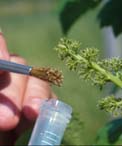
Planting Seeds & Making Selections
Grape Breeding Program Information
Authored by: Bruce I. Reisch and Philip Stewart, 2001.

Planting the Seeds
Over the course of the season, berries on the cluster mature and ripen within the bags. The clusters are collected and the seeds extracted from within the berries. These seeds contain embryos of new plants with an equal amount of genetic material from each parent, and each is genetically distinct. In order to separate inviable seeds from the viable, the seeds are dropped into a small beaker of water. Inviable seeds tend to float, and are skimmed off and discarded. The remainder are cleaned of any remaining pulp, dried, and stored at -20 C / 0 F.
Grape seeds require stratification in order to germinate well. In our program, this stratification is provided by placing the seeds, along with a dilute solution of fungicide on filter paper, in plastic bags and placing them in the refrigerator (5 C / 40 F) for approximately three months. Without this chilling period, seed germination rates would be very low and uniformity in growth among those germinating would be poor. There are many variations on this stratification technique. Some researchers have utilized hydrogen peroxide and or gibberellic acid to reduce the time required for stratification or to increase germination percentage.
In March, the seeds are planted in small peat pots and germinated in the greenhouse. After danger of frost has passed, they are moved outdoors to a sheltered "cold frame" location, where they can be covered if sub-freezing temperatures are expected. In June, our seedlings are planted outdoors into an irrigated nursery site.
Making Selections
A long term commitment is necessary to find the best selections once you've successfully made crosses and produced seedlings. The more seedlings planted and the longer spent evaluating them, the better the chance of finding the exceedingly rare selection with potential. However, the reality is that there are always limits in terms of time, space, and manpower. In the past, our program has transplanted all of the seedlings grown in the nursery into the vineyard. In the last few years, however, many seedlings have been eliminated in the nursery, where they are grown without disease control. Only vines appearing to be disease resistant in the nursery are then transplanted to a permanent vineyard location for further evaluation.
It is more difficult to select for some other characteristics such as wine quality or cold hardiness, and several years of growth in the vineyard are required for proper evaluation. The criteria used depend on your goals. Persistence, creativity, knowledge of grape genetics, careful evaluation and some amount of luck are the keys to success.